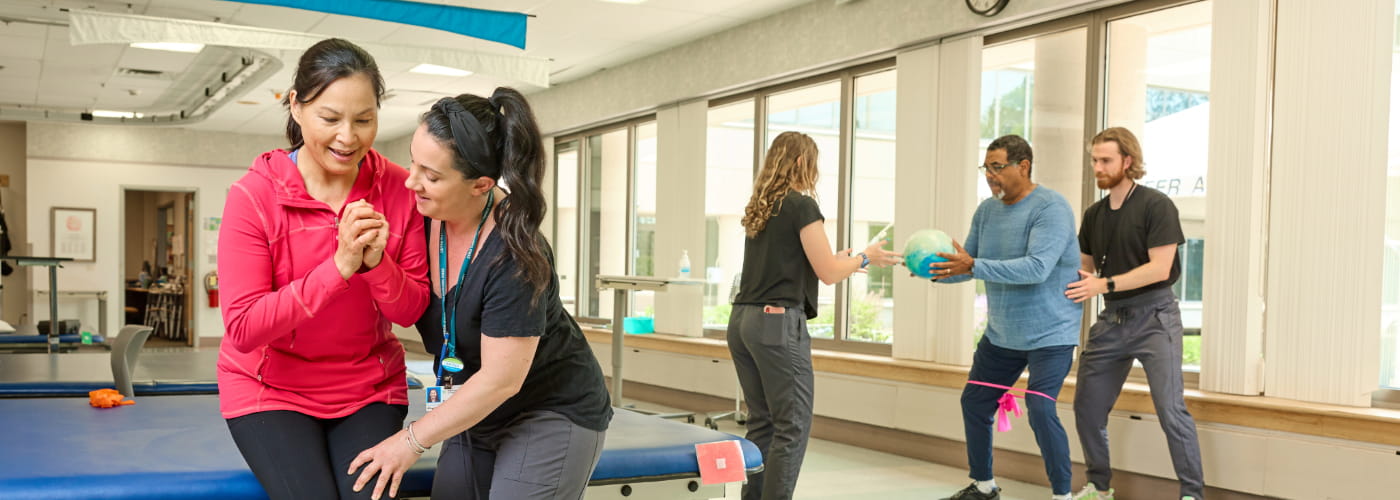Understanding Guillain-Barré syndrome

Your immune system is crucial for your survival. It protects you from infection by attacking things like viruses, bacteria and fungi. But sometimes the immune system can malfunction. In Guillain-Barré Syndrome (GBS), your immune system attacks your nerves.
What are the symptoms of Guillain-Barré syndrome?
GBS typically presents as sudden weakness and tingling that starts in your feet and legs. Symptoms then spread to your arms and upper body. However, for some people, the first symptoms can present in the face.
As GBS symptoms worsen, muscle weakness can turn into paralysis, or inability to move, that spreads throughout your body. "Paralysis is ascending, meaning that it travels up the limbs from fingers and toes towards the torso," explains Maria Harris, PT, DPT, inpatient physical therapist at Bryn Mawr Rehab Hospital, part of Main Line Health. "Loss of reflexes, such as the knee jerk, is also present."
Other symptoms of Guillain-Barré syndrome may include:
- Difficulty walking or climbing stairs
- Trouble with facial movement, including speaking, swallowing and chewing
- Vision problems, like double vision and inability to move the eyes
- Intense pain that feels like cramps, aches or shooting pains (and may get worse at night)
- Trouble with bladder control or bowel function
- Increased heart rate
- Difficulty breathing
- Low or high blood pressure
In many cases, the most severe weakness occurs within two weeks after first experiencing symptoms. Though the condition is rare, it can be serious and lead to complete paralysis of your body, often requiring hospitalization.
GBS is a neurological condition that affects 3,000 to 6,000 people in the United States each year and is estimated to affect about one person in 100,000 each year worldwide.
What causes Guillain-Barré syndrome?
The precise cause of GBS is unknown; however, the majority of people report recent symptoms of an infection in the six weeks prior to developing GBS. It is thought that after this infection, the immune system begins to attack itself.
"Most GBS cases usually start a few days or weeks following a respiratory or gastrointestinal viral infection. Studies are also finding links to flu, Zika and COVID-19 viruses," explains Maria.
Some people associate GBS with vaccinations. Dr. Maureen Su at UCLA Medical and a member of the Global Medical Advisory Board for the GBS/CIDP Foundation International states, "In a recent paper published in The Lancet (2023), Peng et al examined the likelihood that autoimmune diseases (including GBS) occur after COVID-19 infection vs. vaccination. The data were clear that the risk of developing autoimmune diseases is higher with COVID-19 infection, and that COVID-19 vaccination decreases the risk. This is an important study being it demonstrates that GBS is more likely to occur after infection with viruses themselves, and vaccinations can decrease this risk." This is also true regarding the flu virus and flu vaccines.
As GBS numbers are on the rise, questions circulate — and it’s important to get the facts straight. Here are some common ones, including whether there’s a cure and when you should seek medical attention.
How important is it to seek medical attention for Guillain-Barré syndrome?
It’s critical to see a health care provider right away if you notice any symptoms, particularly tingling in your toes or fingers that won’t go away. If you experience severe symptoms — such as tingling or weakness that spreads to the rest of your body, shortness of breath while lying flat or choking on saliva — go to the emergency room or call 911.
"GBS can be life-threatening, as one-third of patients require mechanical ventilation," Maria explains. Mechanical ventilation involves a machine breathing for you or helping you breathe when you can’t on your own.
She also says that patients who are diagnosed and receive treatment within the first two weeks of symptoms have a reduced risk of respiratory failure (a condition that makes it challenging to breathe on your own). They also have better outcomes in terms of recovery time, not needing artificial ventilation or needing it for less time and walking on their own.
What treatments are used for Guillain-Barré syndrome?
There is no known cure for Guillain-Barré syndrome. There are many treatment options that reduce symptoms and shorten the duration of illness. They also lower your chances of long-term symptoms like trouble walking.
"There are two commonly used treatments that are equally effective if started within two weeks of GBS symptoms," says Maria. "These include plasma exchange (also known as plasmapheresis) and intravenous immunoglobulin therapy (IVIg)."
Plasma exchange is when the liquid part of your blood (called plasma) is filtered out from your blood cells. Then, your blood cells are injected back into your body, signaling your body to create more plasma. This process is effective because it removes antibodies from your plasma that are a part of your immune system’s attack.
Intravenous immunoglobulin (IVIg) therapy is when you receive healthy antibodies from donated blood. This blocks antibodies that are linked to Guillain-Barré syndrome.
Serious cases of GBS may require ventilatory support to help you breathe. You may also be given medicine for pain relief and to prevent blood clots while you aren’t moving around.
What does long-term recovery look like for patients with Guillain-Barré syndrome?
"As a patient’s medical status improves, patients may be transferred to an inpatient rehabilitation facility, where the focus is to resume mobility-related activities and activities of daily living," Maria says.
In inpatient rehab you may work with physical, occupational and speech-language therapists to improve strength and help you with daily activities before going home. You might also use other forms of treatment, such as bracing, splinting, equestrian therapy and aquatic therapy.
Once discharged from inpatient rehab, ongoing therapy at home or as an outpatient helps with long-term side effects, such as fatigue and pain. Some patients also experience psychological distress. A strong support network, including a support group or a psychologist, is helpful in navigating recovery.
Where can I learn more about Guillain-Barré syndrome?
Researchers are always discovering more about the diagnosis and treatment of Guillain-Barré syndrome. If you’re interested in staying up-to-date about GBS, head to the GBS/CIDP Foundation International website and register for additional information.
If you know of someone who has been diagnosed with GBS, or who could benefit from highly skilled therapies and a Physical Medicine and Rehab (PM&R) consultation, call Bryn Mawr Rehab’s clinic at 484-596-5207 to schedule an appointment.
Next steps:
Learn more about physical, occupational and speech-language therapists at Main Line Health
6 reasons to go to rehabilitation
 Content you want, delivered to your inbox
Content you want, delivered to your inbox
Want to get the latest health and wellness articles delivered right to your inbox?
Subscribe to the Well Ahead Newsletter.
